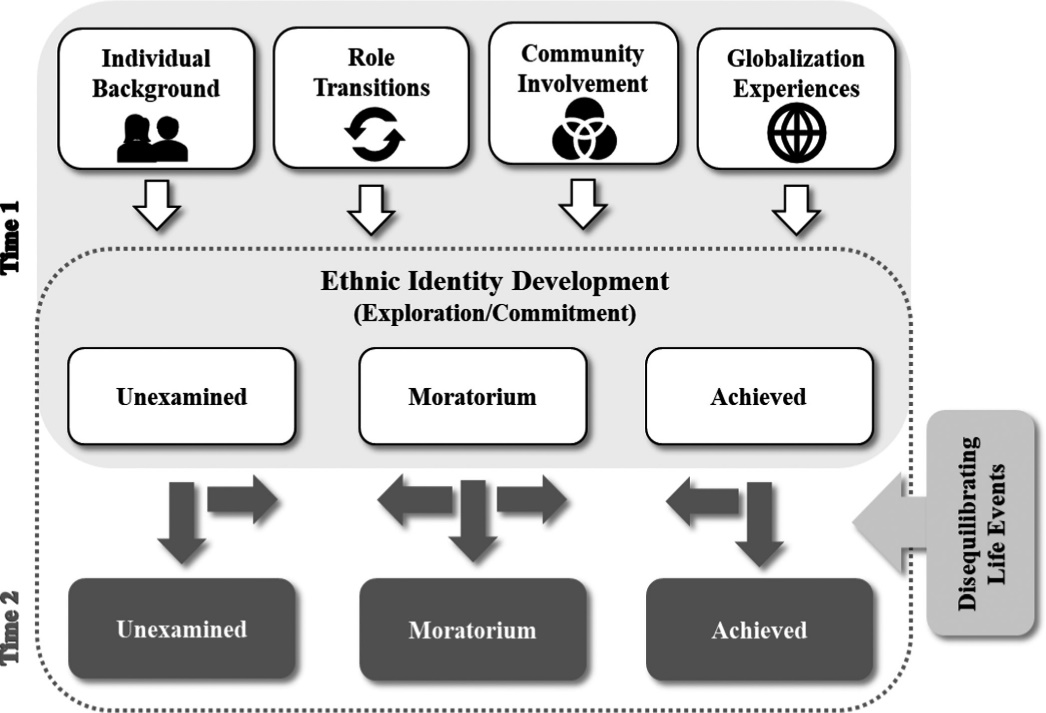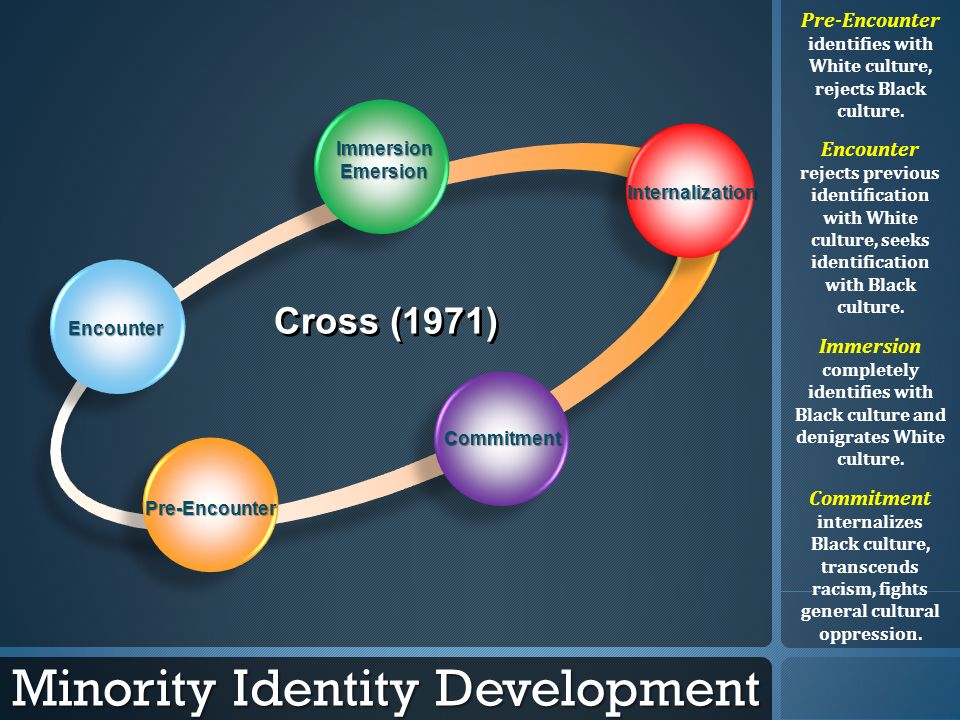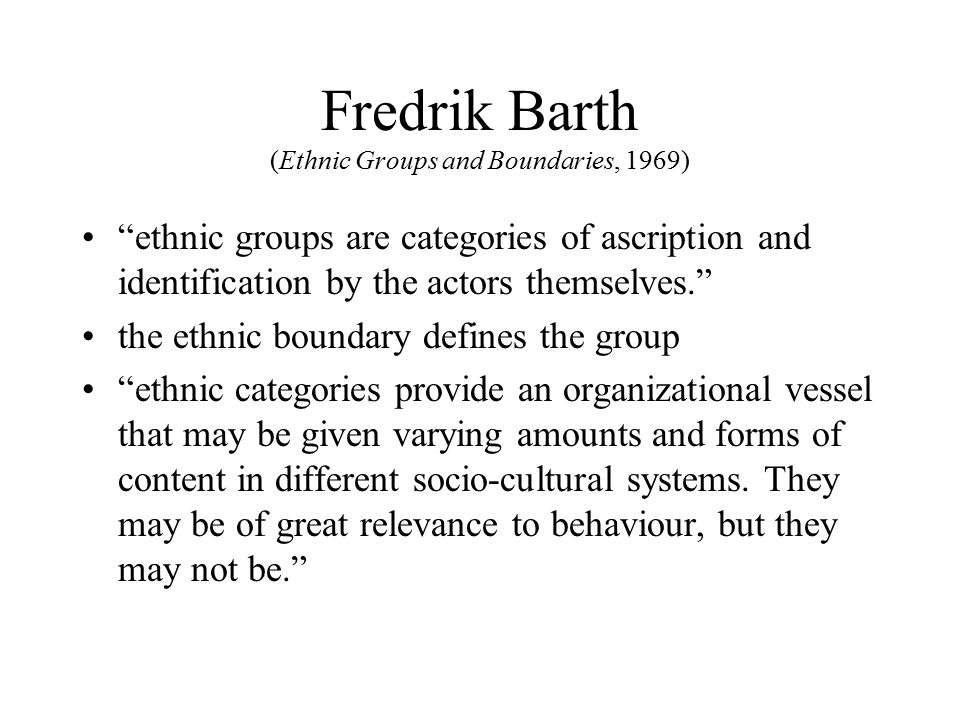Introduction
Multicultural psychology is a broad subject that covers a wide array of topics that focus on identity and social concepts. The subject helps society view culture as a major issue that facilitates understanding human experiences. Through multicultural psychology, the identity of different types of people enables assimilation and interaction of heritages where many backgrounds and cultures are shared. For instance, through the broad subject, students learn about people from different parts of the world as immigrants who entered the US and became part of the country’s citizens, creating ethnic diversity. An example of a specific topic in multicultural psychology is ethnic and racial identity development. Ethnic identity is influenced by unexamined, moratorium and achieved stages, while racial identity is felt through pre-encounter, encounter, immersion, internalization, and commitment stages, as seen in theories of William Cross, Beverly Tatum and Thomas Barth.
Ethnic and Racial Identity Development
Knowledge about ethnicity and racial foundations is essential to every person in society. Belonging to a particular group and identifying oneself with that group helps a person to have shared commitment or values that facilitate the development of ethnicity and racial metrics (Meca et al. 92). People who belong to minority groups get an understanding of how they came to existence in the diverse cultural identities. Various stages in ethnic identity development have been revealed in multicultural psychology. The stages include unexamined ethnicity, moratorium, and achieved (See Figure 1). Unexamined, which is also known as diffused, involves a person, an adolescent who does not consider the reality of ethnic structures. That means these groups may transition to adulthood without having a specific understanding of formations in ethnic identities. It happens to members of the dominant culture in a given region.

A child growing up in regions with many white people compared to African Americans, Latinos, and Asians may not have a sense of ethnic identity as they would assume everyone should appear similar to themselves. That is different from a black American student who grows up and goes to school amongst the whites where they can see they belong to a different identity of ethnic profiles (Boothe 44). These young people need to get early knowledge about the ethnic groups that exist in society so that they will not have prejudice or stereotyping when they become adults in the future. Prejudice is a social concept where a person has an assumption concerning a specific matter as having distinct characteristics of superiority or inferiority. Stereotyping is a context of associating particular people with certain traits, appearances, and psychological structures. For instance, in regions where there are more whites than other races, a stereotype of excellence for the dominant group might be rampant where it is assumed success factor is influenced by racial formation. That means many people will associate non-whites with inferior inferences which might bring societal discrimination.
A moratorium is a stage where an adolescent search for the meaning of the identity they belong in society. It means researching the historical perspectives of the community where they belong or learning the language, which forms part or role transition, as seen in Figure 1. At this stage, a person will actively participate in pro-ethnic cultural activities, depending on their identity. A person may explore their identity through inspiration from a global event related to the group (Boothe 94). Additionally, the trigger may come from the death of an elderly member who belongs to the same identity. This stage is critical as it develops a person’s mind to accept vast social and cultural happenings, which complements the broad subject of multicultural psychology.
The last stage of achievement means the occasions that come after exploration and finding of identity that one belongs to as far as societal setting is concerned. It incorporates a feeling of a secure sense of identity; thus, a person starts interacting with others without getting psychological distraction by what identity is their counterpart (Brown 136). The achieved stage is important since it makes a person settle with the reality that culture is built by many ethnic identities through interactions from one point to another. Therefore, these three stages are critical in developing ethnic identity in multicultural psychology.
Racial Identity Statuses and Development
Racial identity development has been studied in many theories in psychology. For example, William Cross’s Nigrescence theory relates the transformation of black identity through various statuses and acquisition of identification (Meca et al. 79). The stages of racial identity are; pre-encounter, encounter, immersion, internalization, and commitment (See Figure 2). The pre-encounter stage involves identity before the encounter, where a person has an initial frame of who they are in the societal identity context. This stage comprises a person’s unawareness and the impact that comes with the same.

Cross argued that people of color perceived an unracialized framing, making them resistant to information that may threaten the nonracial aspect. The encounter stage means a person experiences occasions that define their identity by raising awareness of what cultural heritage a person belongs to depending on the color of their skin, eyes, and hair (Meca et al. 80). In most cases, the encounter stage may make someone vulnerable of their experiences or feel superior depending with the context. For instance, an encounter may involve a child being treated differently by others due to their physical complexion.
The other stage is immersion, where an individual reacts directly to the fact that they have discovered their identity. A black person may be adamant about proving that their race is equal to others and takes pride in it. In that case, African Americans will be bold to show that one’s skin color influences no limitation by excelling in any criteria involving all races. On the part of whites, those who realize that there are stereotypes that their race is superior to others start acting as if they are more abled (Jakoubek 191). However, this stage may involve the dominant race accepting the difference and supporting equality to ensure no discrimination against the minority group races. It involves a person being committed to conscious activities that belong to their race by excluding others. For instance, there starts a split between black and white learners while playing in school, where each side strongly takes pride in their identity.
The internalization stage involves openness to cognition and psychological defensiveness where a person starts developing the need to interact with others who may not belong to their racial identity. The stage involves solving prejudice-based conflicts with a mutual understanding of the difference in racial structures in the community (Boothe 133). There is less rejection from other groups since anxiety leads to acceptance of the gap of understanding in the previous stage. A theory by Beverly Tatum argues that identity is complex due to shared individual traits, family dynamism, and sociopolitical factors that determine how one perceives their race (Boothe 130). Internalization applies the theoretical perspectives of Tatum by incorporating stern and over-simplistic metrics belonging to one race while accepting the capability of the other. That means people at this stage may begin to have a uniform worldview concerning their race hence, contributing to harmony in a given society.
The commitment stage calls for balancing one’s racial identity and that of others. The difference between people who have internalized their identity and overlook the need to foster social change is seen in those who continue their involvement in the push for social changes (Syed et al. 59). The success factor of this stage is brought in by the aspect of accepting the new identity and participating in essential activities that call for equality and political justice that seeks to unify all members of different racial groups. Self-hatred is not experienced, nor does a person feel superior that another other based on their race (Syed et al. 65). These stages are important in the integration of the development of racial identity, which serves as an evaluation of what a person needs to do to have positive concepts of ethnic and racial differences in the community.
Barth’s Theory of Ethnicity Development
Many researchers view ethnicity as a wide topic, but everyone has their basis for its development. Thomas Barth, in his theoretical framework argued that ethnic groups “entail social processes of exclusion and incorporation whereby discrete categories are maintained despite changing participation and membership in the course of individual life histories” (Jakoubek 183). By that, Barth meant that ethnicity profiles are developed across boundaries evident for different sets of people in terms of race and culture. As a result, many ascriptions and self-ascriptions maintain the notion of difference in ethnic and racial concepts (See Figure 3). Barth’s theory shows that ethnic identity is developed by the feeling of exclusion and inclusion for different members of cultural groups where a feeling of superiority and inferiority is felt.

Barth’s framework complements the stages of ethnic identity. The statuses in different racial identities prove that ethnicity is a primordial bond that focuses on the inter-differences between groups (Syed et al. 58). Ethnic and racial identity developments continue to happen in different levels of life starting from childhood, teenage, adulthood, and rarely old age. Thus, a person’s identity may depend on what they learn while young and what was fostered in the community they lived in.
Conclusion
Ethnic and racial identity development is significantly felt during adolescence when a person is experiencing growth. Ethnicity refers to belonging to a given heritage with certain cultural features or a distinct group of people with shared values. Racial identity comprises the sense of feeling of difference in physical complexion. Ethnicity and racial differences may bring prejudice and serotyping depending on a person’s perception of their identity. Ethnicity identity development comprises unexamined, moratorium, and achieved stages. Racial identity is developed through pre-encounter, encounter, immersion, internalization, and commitment. Various theorists such as William Cross, Beverly Tatum, and Thomas Barth help contextualize racial and ethnic identity development. A person will experience various stages when it comes to the development of their identity, and that is part of the broad topic of multicultural psychology.
Works Cited
Boothe, Demico. US Child Support System and the Black Family: How the System Destroys Black Families, Criminalizes Black Men, and Sets Black Children up for Failure. Full Surface Publishing, 2018.
Brown, Keah. The Pretty One: On Life, Pop Culture, Disability, and Other Reasons to Fall in Love with Me. Atria Paperback, 2019.
Jakoubek, Marek. “A Breakthrough of Ethnic Groups and Boundaries – Reality or a Myth? (On Amnesia in Ethnicity Studies).” vol. 22, no. 2, 2021, pp. 177–195. Ethnicities, Web.
Meca, Alan, et al. “Cultural Identity Development among Ethnic-Racial Minorities: An Examination of Ethnic-Racial Identity, National Identity, and Biculturalism.” vol. 5, no. 7, 2023, pp. 79–92., Encyclopedia of Child and Adolescent Health, Web.
Syed, Moin, et al. “Toward a New Understanding of Ethnic/Racial Settings for Ethnic/Racial Identity Development.” Vol. 3, no. 6, 2018, pp. 56–66., Journal of Social Development, Web.
